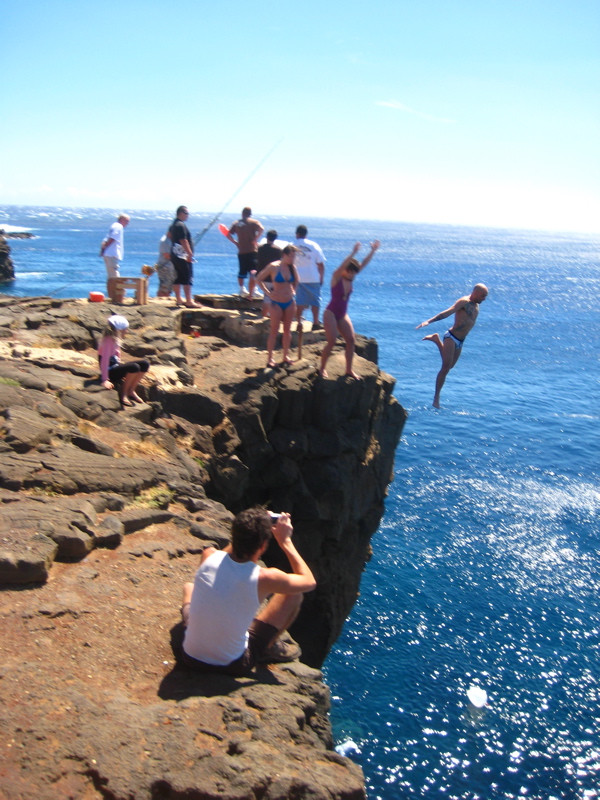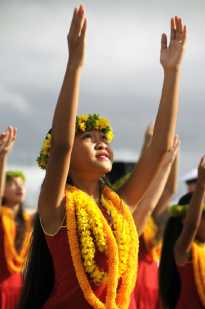St. Jude’s has exceeded my expectations in every way. A congregation
of about 40 – which seems huge to me – fills up the small church. Very lively
and friendly. I got my SECOND real-orchid
lei
just before the procession today. As I walked into the church earlier, I almost
wept when I saw them practicing for their offertory dance – a
hula that tells the story of the Rich
Young Man. The music was heart-breakingly beautiful – that female slow yodel,
sliding between registers. I felt like I was going to heaven. They blow a conch, in place of the sacristy bell, to indicate the beginnign of the procession. Every Sunday, after the Prayers of the People and before the Confession, they
also sing a hymn entirely in Hawai’ian, written by the late Queen Lili’uokalani.
Your loving mercy and your truth so perfect.
I live imprisoned in sorrow; you are my Light;
you Glory my support.
Behold not with malevolence the sins of humankind,
but forgive and cleanse.
And so, O Lord, beneath your wings protect us,
and let peace be our portion now and forever more.
The prison to which Her Majesty refers is her own Iolani Palace, now the State Capitol, to which she was confined after her conviction for conspiring against the American jjunta taht caleld itself the Republic of Hawai'i. If you haven’t had your daily outrage, google
her and the links that tell of her overthrow, denounced as a betrayal of our
values by no less than the sitting President, Grover Cleveland! She abdicated in order to
prevent bloodshed. She and all other loyal Hawai’ians wore mourning black and
shuttered their houses the day we annexed Hawai’i as a Territory.
Queen Lili'uokalani also wrote the very famous Aloha 'oe, the signature song of Hawai'ian music. The whole royal family seems to have been quite poetic and musical.
The congregation is diverse and committed to social justice.
There were some Marshallese boys, who had come to the free shower the church
provides on Saturdays. These are the poorest of the poor, made so by:

Bikini Atoll, Marshall Islands, March 1, 1954
1.
Their deportation here when we used their home
islands to test the H-bomb. This made their homeland the most contaminated place on earth.
The old story:
- We taught the newcomers English and
those who could learn left for Honolulu.
- The weaker stayed here to work on the
cane plantations. Sugar went out of business because of
globalization, and now these people have nothing.
- Many of the Marshallese live in abandoned vehicles and their
only water is what falls out of the sky.
In the United States of America. (Although that's pretty much true of everyone here,
but there is an elaborate system of cisterns for those with houses.) This
district of the County of Hawai’i (each island is a county) is the poorest in
the whole USA.
Anyway, there are old hippies and wanderers from all over in
the congregation, including the C lerkof the Bishop’s Committee, who made sure
to inform me that her daughter lived with her husband and two wives and
celebrated their “polyamorous” anniversary recently. This is, after all, still
Polynesia,
Refreshing, somehow.
The only trouble in paradise so far is Halemaumau, a small volcano nearby that emits something called vog. It is volcanic effluent that produces
a haze as far as Honolulu. Some are deathly allergic to it. So it is not always
clear skies around here. But the temperature is perfect. Blanket weather at
night and in the high ‘70s in the daytime. At this altitude. Like AZ, altitude
makes a big difference, and the church is at about 2500 feet4. Warmer down by
the ocean, I guess. And in the dry season (our summer months), when it gets
pretty toasty and humid. But anyway, there is no furnace! Just a little electric
space heater, if needed.
Oh yeah - there ARE mosquitos - very small and polite by MN standards. And not very many - not much standing water, after all.
The house is up on stilts, surrounded on three sides by a lanai (verandah). The house itself is
uncannily like the one in Bayfield, except a little fancier, with French doors
out to the lanai and a private bathroom
off the master bedroom. There is a nice little shopping mall a couple of miles
away, where the big super market has everything – at slightly elevated prices,
since everything is imported. EXCEPT the grass-fed beef, which is way cheap.
Much better price than at home. And pork is better yet. Fortunately there is a
nice big outdoor grill down in what would have been the garage, on ground
level. They have turned it into an inviting, open-air ramada with nice lawn furniture, washing machines, and grill. There
is also a garden in the amended lava, including fruiting tomatoes. Quite a
treat.
The next-door neighbor is a coffee-farmer, who also roasts
right there, so there is nice aroma all the time. I expect to get some green Ka’u beans from him. That subset of Kona coffee regularly wins “best-of”
awards at international competitions.
So now it is also the rainy season, and it is raining today.
Good. Fill up them cisetrns!
So enough for now. To my Sunday afternoon nap, cradled by the strains fo the Assembly if God congregation that meets in St. Jude's in the afternoon, singing a slack-key, Hawai'ian version of the old country-gospel, slow waltz hymn, Further Along.




.jpg)
.jpg)








